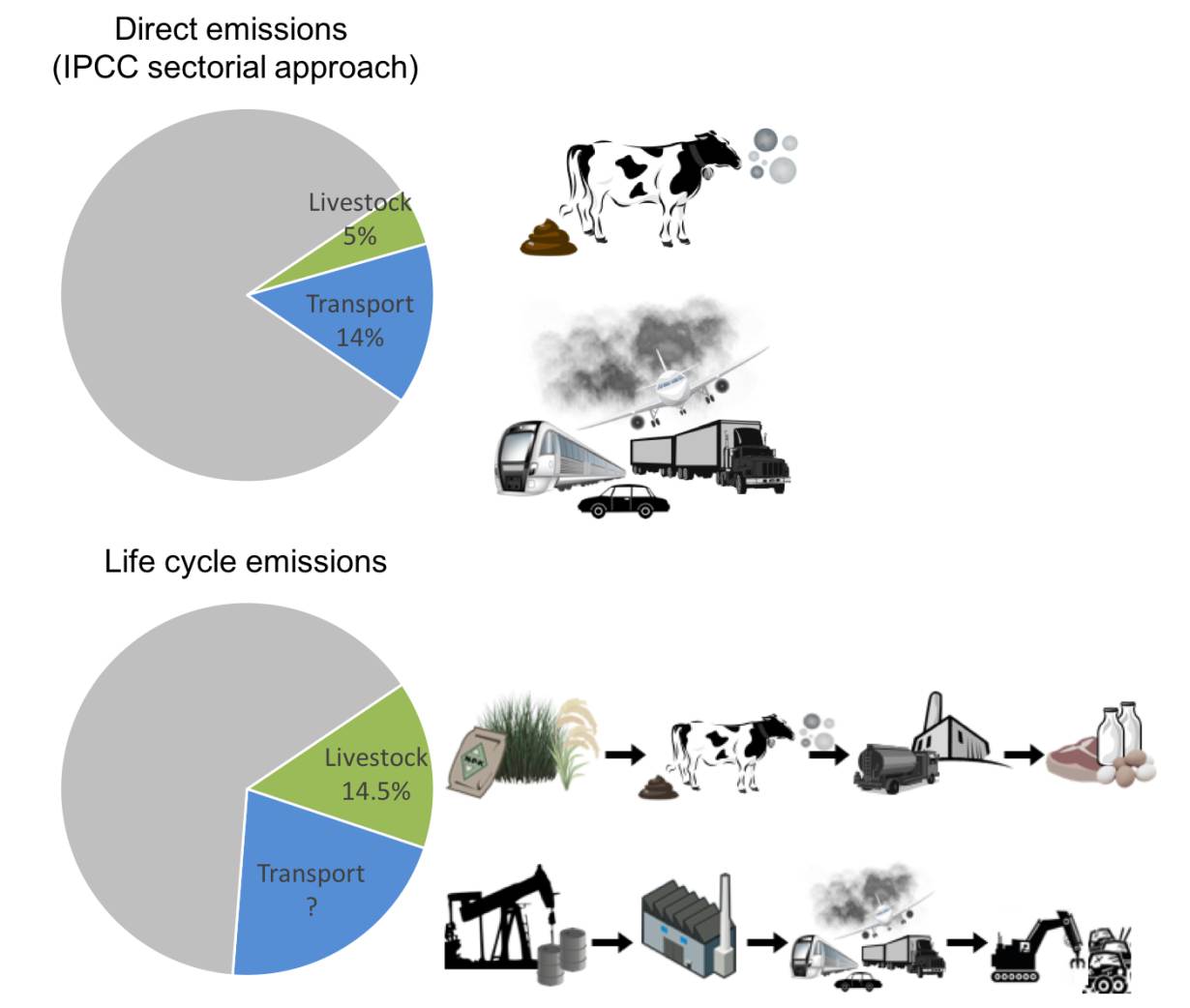FAO on the common but flawed comparisons of greenhouse gas emissions from livestock and transport
- From
-
Published on
19.09.18
- Impact Area

Graphic by FAO.
Livestock experts Anne Mottet and Henning Steinfeld, of the Food and Agriculture Organization of the United Nations (FAO), warn of the pitfalls of simplification when looking at greenhouse gas emissions from livestock. . . .
[G]reenhouse gas emissions from livestock and transport are often compared, but in a flawed way.
‘The comparison measures direct emissions from transport against both direct and indirect emissions from livestock. The Intergovernmental Panel on Climate Change (IPCC) identifies and monitors human activities responsible for climate change and reports direct emissions by sectors. The IPCC estimates that direct emissions from transport (road, air, rail and maritime) account for 6.9 gigatons per year, about 14% of all emissions from human activities. These emissions mainly consist of carbon dioxide and nitrous oxide from fuel combustion. By comparison, direct emissions from livestock account for 2.3 gigatons of CO2 equivalent, or 5% of the total. They consist of methane and nitrous oxide from rumen digestion and manure management. Contrary to transport, agriculture is based on a large variety of natural processes that emit (or leak) methane, nitrous oxide and carbon dioxide from multiple sources. While it is possible to “de-carbonize” transport, emissions from land use and agriculture are much more difficult to measure and control.
‘Using a global life cycle approach, FAO estimated all direct and indirect emissions from livestock (cattle, buffaloes, goat, sheep, pigs and poultry) at 7.1 gigatons of CO2 equivalent per year, or 14.5% of all anthropogenic emissions reported by the IPCC. In addition to rumen digestion and manure, life cycle emissions also include those from producing feed and forages, which the IPCC reports under crops and forestry, and those from processing and transporting meat, milk and eggs, which the IPCC reports under industry and transport.
Hence, we cannot compare the transport sector’s 14% as calculated by the IPCC, to the 14.5% of livestock using the life cycle approach.
‘Though it is the most systematic and comprehensive method for assessing environmental impacts according to the IPCC, there is no life cycle approach estimate available for the transport sector at a global level to our knowledge. Non-availability, uncertainty or variability of data limit its application. But several studies, including some reported by the IPCC, show that transport emissions increase significantly when considering the entire life cycle of fuel and vehicles, including emissions from extracting fuel and disposing of old vehicles. For example in the US, greenhouse gas emissions for the life cycle of passenger transport would be about 1.5 times higher than the operational ones.
‘Comparing transport and livestock raises another issue. Wealthy consumers, in both high and low income countries, who are rightly concerned about their individual carbon footprint, have options like driving less or choosing low carbon food. However, more than 820 million people are suffering from hunger and even more from nutrient deficiencies. Meat, milk and eggs are much sought after to address malnutrition. Out of the 767 million people living in extreme poverty, about half of them are pastoralists, smallholders or workers relying on livestock for food and livelihoods.
The flawed comparison and negative press about livestock may influence development plans and investments and further increase their food insecurity.
‘. . . The world needs both consumers that are aware of their food choices and producers and companies that engage in low carbon development. In that process, livestock can indeed make a large contribution to climate change mitigation, food security and sustainable development in general.’
Read the whole article by FAO’s Anne Mottet and Henning Steinfeld on the Thomson Reuters Foundation News: Cars or livestock: which contribute more to climate change?, 18 Sep 2018.
![]()
Related news
-

CGIAR Climate Security team pilots a new research approach for the development of Nature-based Solutions in fragile settings
Ibukun Taiwo27.11.25-
Climate adaptation & mitigation
Responding to complex crises requires new systemic research approaches that help identify entry poin…
Read more -
-

From Dirt to Decision-Making: Governance and Soil Health Must Go Hand in Hand
Multifunctional Landscapes Science Program26.11.25-
Biodiversity
-
Environmental health
-
Environmental health & biodiversity
In October, the world convened in Des Moines for the 2025 Borlaug Dialogue under the…
Read more -
-

Drones prove their worth in measuring livestock methane in Africa
International Livestock Research Institute (ILRI)26.11.25-
Mitigation
In May 2024, the International Livestock Research Institute (ILRI) and partners shared news of the…
Read more -

